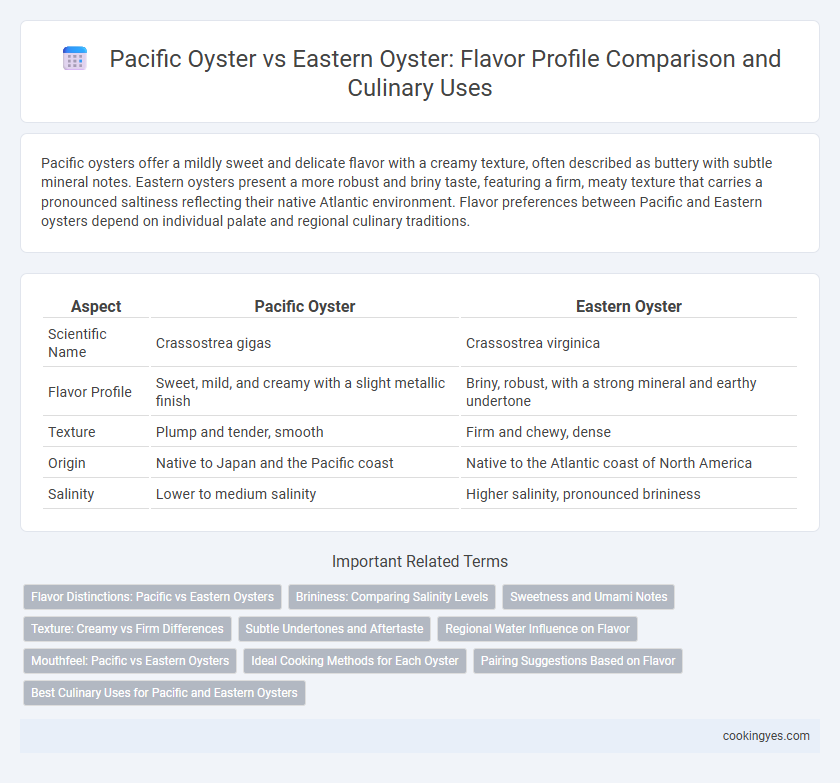Pacific oysters offer a mildly sweet and delicate flavor with a creamy texture, often described as buttery with subtle mineral notes. Eastern oysters present a more robust and briny taste, featuring a firm, meaty texture that carries a pronounced saltiness reflecting their native Atlantic environment. Flavor preferences between Pacific and Eastern oysters depend on individual palate and regional culinary traditions.
Table of Comparison
| Aspect | Pacific Oyster | Eastern Oyster |
|---|---|---|
| Scientific Name | Crassostrea gigas | Crassostrea virginica |
| Flavor Profile | Sweet, mild, and creamy with a slight metallic finish | Briny, robust, with a strong mineral and earthy undertone |
| Texture | Plump and tender, smooth | Firm and chewy, dense |
| Origin | Native to Japan and the Pacific coast | Native to the Atlantic coast of North America |
| Salinity | Lower to medium salinity | Higher salinity, pronounced brininess |
Flavor Distinctions: Pacific vs Eastern Oysters
Pacific oysters (Crassostrea gigas) offer a milder, slightly sweet flavor with a creamier texture, often reflecting the mineral-rich waters they inhabit. Eastern oysters (Crassostrea virginica) present a brinier, more robust taste with a pronounced salty finish, influenced by their estuarine environments. These flavor distinctions make Pacific oysters ideal for those preferring subtle, buttery notes, while Eastern oysters appeal to palates seeking a bolder, oceanic intensity.
Brininess: Comparing Salinity Levels
Pacific Oysters typically exhibit a milder brininess with a subtle, sweet undertone, reflecting the lower salinity levels of their native waters in the Pacific Northwest. Eastern Oysters possess a more pronounced saltiness and robust briny flavor due to higher salinity in Atlantic and Gulf Coast habitats. These differences in salinity directly influence the oysters' flavor profiles, making Pacific Oysters smoother and Eastern Oysters more intensely savory.
Sweetness and Umami Notes
Pacific oysters offer a distinct flavor profile characterized by a pronounced sweetness balanced with subtle umami notes, making them popular for raw consumption. Eastern oysters tend to exhibit a brinier taste with a more intense umami presence, often described as robust and savory. Sweetness in Pacific oysters is typically higher due to their glycogen content, while Eastern oysters' umami richness stems from elevated glutamic acid levels.
Texture: Creamy vs Firm Differences
Pacific oysters feature a creamy texture with smooth, buttery flesh that melts in the mouth, offering a rich and velvety experience. Eastern oysters present a firmer texture, with a slightly chewy consistency that provides a more robust bite and a pronounced briny character. These textural differences influence pairing choices, with Pacific oysters favoring delicate accompaniments and Eastern oysters complementing bold flavors.
Subtle Undertones and Aftertaste
Pacific oysters deliver a delicate flavor profile with subtle mineral and sweet undertones, often described as clean and slightly briny. Eastern oysters feature a richer, more robust taste marked by earthy and buttery notes that linger on the palate. The aftertaste of Pacific oysters is typically light and crisp, while Eastern oysters leave a deeper, more complex finish.
Regional Water Influence on Flavor
Pacific oysters (Crassostrea gigas) develop a briny and sweet flavor influenced by the cooler, mineral-rich waters of the Pacific Northwest, creating a clean and slightly fruity profile. Eastern oysters (Crassostrea virginica) reflect the warmer, estuarine environments of the Atlantic coast, often carrying a saltier, earthy taste with a subtle metallic finish. Regional water characteristics such as salinity, temperature, and nutrient composition directly impact the oysters' flavor complexity and texture.
Mouthfeel: Pacific vs Eastern Oysters
Pacific oysters deliver a creamy, buttery mouthfeel with a rich, almost sweet finish, offering a complex texture that lingers on the palate. Eastern oysters present a firmer, more briny bite with a crisp, clean texture, emphasizing a mineral-driven experience. The difference in mouthfeel highlights the Pacific's smooth, velvety character compared to the Eastern's bright, crisp sensation, making each ideal for distinct culinary preferences.
Ideal Cooking Methods for Each Oyster
Pacific oysters have a briny, slightly sweet flavor with a creamy texture, making them ideal for grilling or roasting to enhance their natural umami notes. Eastern oysters offer a more robust, salty, and mineral-rich taste, which complements steaming or smoking methods that preserve their bold character. Both oysters' unique flavor profiles benefit from cooking techniques that highlight their intrinsic qualities without overpowering their delicate balance.
Pairing Suggestions Based on Flavor
Pacific oysters offer a briny, sweet flavor with subtle metallic notes that pair excellently with crisp, acidic accompaniments like citrus mignonette or a Sauvignon Blanc wine. Eastern oysters present a more robust, briny, and earthy profile, making them ideal for richer pairings such as a full-bodied Chardonnay or a tangy cocktail sauce with horseradish. Seafood dishes featuring fresh herbs like dill or parsley enhance both oyster varieties by balancing their distinct flavor profiles.
Best Culinary Uses for Pacific and Eastern Oysters
Pacific oysters offer a sweet, mild flavor with a buttery texture, making them ideal for raw consumption, grilling, or light steaming to preserve their delicate taste. Eastern oysters have a brinier, robust flavor with a firmer texture, suitable for hearty preparations like frying, smoking, or incorporation into stews and chowders. Both oyster varieties excel in enhancing dishes, with Pacific oysters favored for subtle seafood plates and Eastern oysters preferred in rich, savory recipes.
Pacific Oyster vs Eastern Oyster for flavor profile Infographic

 cookingyes.com
cookingyes.com